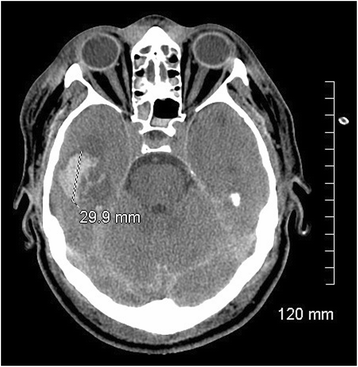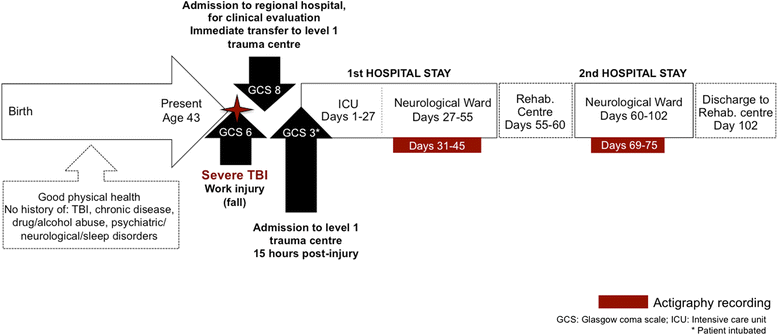Evolution of severe sleep-wake cycle disturbances following traumatic brain injury: a case study in both acute and subacute phases post-injury
- PMID: 27677675
- PMCID: PMC5039911
- DOI: 10.1186/s12883-016-0709-x
Evolution of severe sleep-wake cycle disturbances following traumatic brain injury: a case study in both acute and subacute phases post-injury
Abstract
Background: Sleep-wake disturbances are frequently reported following traumatic brain injury (TBI), but they remain poorly documented in the acute stage of injury. Little is known about their origin and evolution.
Case presentation: This study presents the case of a patient in the acute phase of a severe TBI. The patient was injured at work when falling 12 m into a mine and was hospitalized in the regular wards of a level I trauma centre. From days 31 to 45 post-injury, once he had reached a level of medical stability and continuous analgosedation had been ceased, his sleep-wake cycle was monitored using actigraphy. Results showed significant sleep-wake disturbances and severe sleep deprivation. Indeed, the patient had an average nighttime sleep efficiency of 32.7 ± 15.4 %, and only an average of 4.8 ± 1.3 h of sleep per 24-h period. After hospital discharge to the rehabilitation centre, where he remained for 5 days, the patient was readmitted to the same neurological unit for paranoid delusions. During his second hospital stay, actigraphy recordings resumed from days 69 to 75 post-injury. A major improvement in his sleep-wake cycle was observed during this second stay, with an average nighttime sleep efficiency of 96.3 ± 0.9 % and an average of 14.1 ± 0.9 h of sleep per 24-h period.
Conclusion: This study is the first to extensively document sleep-wake disturbances in both the acute and subacute phases of severe TBI. Results show that prolonged sleep deprivation can be observed after TBI, and suggest that the hospital environment only partially contributes to sleep-wake disturbances. Continuous actigraphic monitoring may prove to be a useful clinical tool in the monitoring of patients hospitalized after severe TBI in order to detect severe sleep deprivation requiring intervention. The direct impact of sleep-wake disturbances on physiological and cognitive recovery is not well understood within this population, but is worth investigating and improving.
Keywords: Actigraphy; Circadian rhythms; Neurocritical care; Neuropsychiatry; Sleep disorders; Traumatic brain injury.
Figures



Similar articles
-
Sleep-wake disturbances in hospitalized patients with traumatic brain injury: association with brain trauma but not with an abnormal melatonin circadian rhythm.Sleep. 2020 Jan 13;43(1):zsz191. doi: 10.1093/sleep/zsz191. Sleep. 2020. PMID: 31562742 Free PMC article.
-
Rest-Activity Cycle Disturbances in the Acute Phase of Moderate to Severe Traumatic Brain Injury.Neurorehabil Neural Repair. 2014 Jun;28(5):472-82. doi: 10.1177/1545968313517756. Epub 2013 Dec 30. Neurorehabil Neural Repair. 2014. PMID: 24379082
-
Towards a better understanding of increased sleep duration in the chronic phase of moderate to severe traumatic brain injury: an actigraphy study.Sleep Med. 2019 Jul;59:67-75. doi: 10.1016/j.sleep.2018.11.012. Epub 2018 Nov 28. Sleep Med. 2019. PMID: 30578112
-
Sleep and wake disturbances following traumatic brain injury.Pathol Biol (Paris). 2014 Oct;62(5):252-61. doi: 10.1016/j.patbio.2014.05.014. Epub 2014 Aug 7. Pathol Biol (Paris). 2014. PMID: 25110283 Review.
-
Sleep-wake disturbances after traumatic brain injury.Lancet Neurol. 2015 Jul;14(7):746-57. doi: 10.1016/S1474-4422(15)00068-X. Lancet Neurol. 2015. PMID: 26067127 Review.
Cited by
-
Validity of actigraphy for nighttime sleep monitoring in hospitalized patients with traumatic injuries.J Clin Sleep Med. 2020 Feb 15;16(2):185-192. doi: 10.5664/jcsm.8162. Epub 2020 Jan 13. J Clin Sleep Med. 2020. PMID: 31992412 Free PMC article.
-
Ambient Stimuli Perpetuate Nighttime Sleep Disturbances in Hospital Patients With TBI.Biol Res Nurs. 2021 Oct;23(4):637-645. doi: 10.1177/10998004211016060. Epub 2021 May 13. Biol Res Nurs. 2021. PMID: 33982620 Free PMC article.
-
The feasibility and reliability of actigraphy to monitor sleep in intensive care patients: an observational study.Crit Care. 2021 Jan 29;25(1):42. doi: 10.1186/s13054-020-03447-8. Crit Care. 2021. PMID: 33514414 Free PMC article.
-
Psychiatric disorders in post-traumatic brain injury patients: A scoping review.Heliyon. 2023 Jan 10;9(1):e12905. doi: 10.1016/j.heliyon.2023.e12905. eCollection 2023 Jan. Heliyon. 2023. PMID: 36704272 Free PMC article.
-
Sleep-wake disturbances in hospitalized patients with traumatic brain injury: association with brain trauma but not with an abnormal melatonin circadian rhythm.Sleep. 2020 Jan 13;43(1):zsz191. doi: 10.1093/sleep/zsz191. Sleep. 2020. PMID: 31562742 Free PMC article.
References
-
- Nakase-Richardson R, Sherer M, Barnett SD, Yablon SA, Evans CC, Kretzmer T, Schwartz DJ, Modarres M. Prospective evaluation of the nature, course, and impact of acute sleep abnormality after traumatic brain injury. Arch Phys Med Rehabil. 2013;94(5):875–82. doi: 10.1016/j.apmr.2013.01.001. - DOI - PubMed
LinkOut - more resources
Full Text Sources
Other Literature Sources

